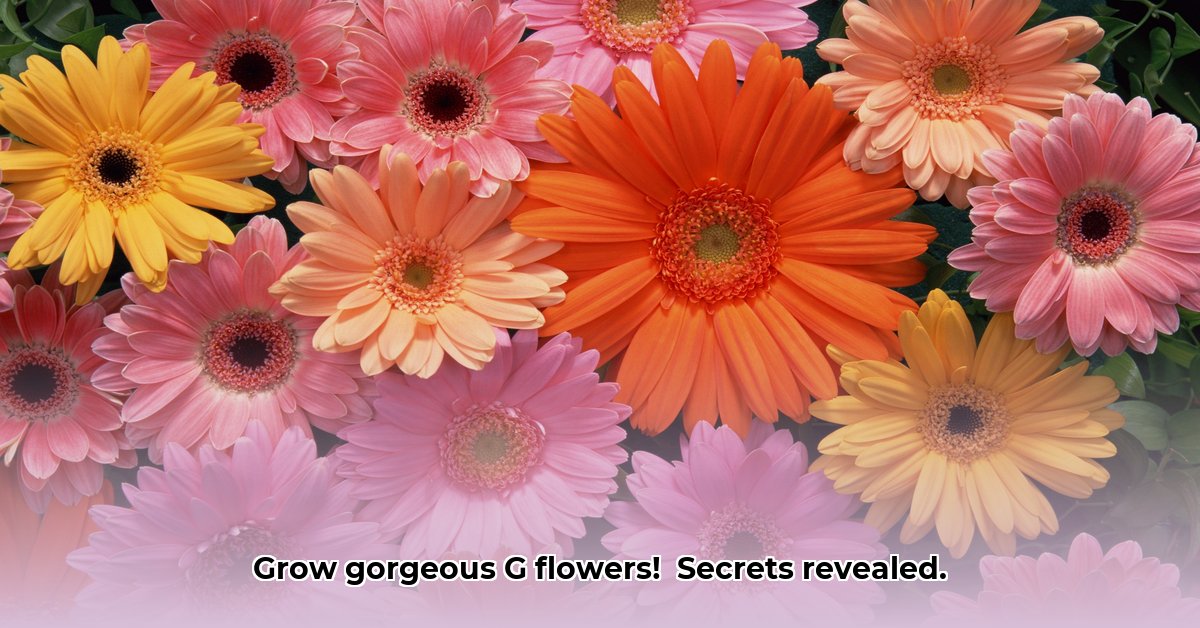Embark on a floral adventure with flowers that start with “G”! This guide covers a diverse range, from the classic Gardenia to the vibrant Gazania. Learn how to grow these beauties, no matter your gardening experience.
“G” Flowers: A Gardener’s Delight
Explore the world of flowers that begin with “G,” offering a diverse palette of colors, shapes, and fragrances. Discover flowers that excite you, and learn some helpful gardening tips.
Gardenia: Fragrant Elegance
Gardenias are prized for their intoxicating fragrance and elegant, creamy-white flowers. These evergreen shrubs bring a touch of Southern charm to gardens. The intense fragrance of Gardenias can fill the air.
Growing Gardenias:
- Acidic Soil: Gardenias require acidic soil with a pH between 5.0 and 6.0. Amend your soil with peat moss or sulfur if needed.
- Partial Shade: Provide partial shade, especially during the hottest part of the day. Morning sun and afternoon shade are ideal.
- Consistent Moisture: Keep the soil consistently moist but not waterlogged. Water deeply when the top inch of soil feels dry.
- Humidity: Gardenias thrive in high humidity. Mist the foliage regularly or place the plant on a pebble tray filled with water.
Gerbera Daisies: Vibrant Blooms
Gerbera daisies are known for their large, cheerful blooms in a wide array of colors. These popular flowers bring a burst of sunshine to any garden or floral arrangement.
Growing Gerbera Daisies:
- Sunny Location: Plant gerbera daisies in a location that receives at least six hours of direct sunlight per day.
- Well-Draining Soil: Use well-draining soil to prevent root rot. Amend heavy clay soil with compost or other organic matter.
- Watering: Water regularly, allowing the top inch of soil to dry out between waterings. Avoid overhead watering to prevent fungal diseases.
- Fertilizing: Feed gerbera daisies with a balanced fertilizer every two to four weeks during the growing season.
- Deadheading: Remove spent flowers to encourage continuous blooming.
Gladiolus: Towering Beauty
Gladioli are known for their tall, stately flower spikes that add vertical interest to gardens. These summer bloomers come in a wide range of colors, making them a favorite for cut flower arrangements.
Growing Gladiolus:
- Sunny Location: Plant gladiolus corms in a sunny location with well-drained soil.
- Planting Depth: Plant corms 4-6 inches deep and 6-8 inches apart.
- Staking: Provide support for tall varieties to prevent them from flopping over.
- Watering: Water regularly, especially during dry periods.
- Fertilizing: Fertilize gladiolus with a high-phosphorus fertilizer when the flower spikes appear.
- Winter Storage: In cold climates, dig up the corms in the fall after the foliage has died back. Store them in a cool, dry place over the winter.
Gaillardia: Drought-Tolerant Color
Gaillardia, also known as blanket flowers, are heat and drought-tolerant perennials that bloom for an extended period throughout the summer. Their daisy-like flowers come in warm shades of red, orange, and yellow.
Growing Gaillardia:
- Full Sun: Plant gaillardia in a location that receives at least six hours of direct sunlight per day.
- Well-Drained Soil: Gaillardia thrives in well-drained soil. Avoid planting in heavy clay soil.
- Watering: Water sparingly, as gaillardia is drought-tolerant once established.
- Deadheading: Remove spent flowers to encourage continuous blooming.
- Division: Divide gaillardia plants every two to three years to prevent them from becoming overcrowded.
Geraniums: Versatile Garden Favorites
Geraniums are versatile plants that can be grown as annuals or perennials, depending on the climate. They come in a wide range of colors and forms.
Growing Geraniums:
- Sunlight: Provide at least six hours of sunlight daily.
- Well-Draining Soil: Use well-draining soil to prevent root rot.
- Watering: Water regularly, but allow the soil to dry out slightly between waterings.
- Fertilizing: Feed geraniums with a balanced fertilizer every two to four weeks during the growing season.
- Deadheading: Remove spent flowers to encourage continuous blooming.
- Pinching: Pinch back the stems regularly to promote bushier growth.
Beyond the Mainstays: Exploring More “G” Flowers
Discover a wider range of “G” flowers, each with its unique appeal:
- Globe Amaranth (Gomphrena): A heat-tolerant annual with clover-like flowerheads.
- Globe Thistle (Echinops): A striking perennial with spherical, blue or silver flowerheads.
- Goldenrod (Solidago): A native perennial with golden-yellow flower spikes.
- Grape Hyacinth (Muscari): A spring-blooming bulb with clusters of tiny, bell-shaped flowers.
- Grevillea: An evergreen shrub or tree with spider-like flowers, native to Australia.
- Gazania: South African native also known as the treasure flower.
| Flower | Bloom Time | Sun Exposure | Hardiness Zone | Characteristics |
|---|---|---|---|---|
| Gardenia | Summer | Partial Shade | 8-11 | Highly fragrant, creamy-white flowers |
| Gerbera Daisy | Spring-Fall | Full Sun | 8-11 (Annual) | Wide range of colors, daisy-like flowers |
| Gladiolus | Summer | Full Sun | 7-10 (Annual) | Tall flower spikes, various colors |
| Gaillardia | Summer-Fall | Full Sun | 3-9 | Drought-tolerant, daisy-like flowers, warm colors |
| Geranium | Spring-Fall | Full Sun/Part Shade | Varies | Wide range of colors and forms |
| Globe Amaranth | Summer-Fall | Full Sun | 2-11 | Clover-like flowerheads, various colors |
| Globe Thistle | Summer | Full Sun | 3-9 | Spherical flowerheads, blue or silver |
| Goldenrod | Late Summer-Fall | Full Sun | 3-9 | Golden-yellow flower spikes |
| Grape Hyacinth | Spring | Full Sun/Part Shade | 4-8 | Clusters of bell-shaped flowers, typically blue |
| Grevillea | Varies | Full Sun | 9-11 | Spider-like flowers, various colors |
| Gazania | Spring-Fall | Full Sun | 8-11 | Bright daisy-like flowers, drought-tolerant |
This guide provides a starting point for exploring the vast world of “G” flowers. With careful planning and proper care, you can create a garden filled with these stunning blooms.
Propagating “G” Flowers from Cuttings
Propagating flowers from cuttings lets you expand your garden affordably and sustainably. For certain “G” flowers, this is essential!
Propagation Techniques
- Select Healthy Cuttings: Choose healthy, non-flowering stems for best results.
- Use Clean Tools: Sharp, sterilized pruning shears prevent disease transmission.
- Rooting Hormone: Dip the cut end in rooting hormone to encourage root development.
- Well-Draining Medium: Use a well-draining rooting medium, such as perlite and peat moss.
- Humidity Control: Maintain high humidity by covering the cuttings with a humidity dome or plastic bag.
- Indirect Light: Provide bright, indirect light to promote root growth.
- Patience: Rooting can take several weeks or even months, so be patient.
Gardenia: Aromatic Propagation
Propagating Gardenias from cuttings allows you to replicate prized cultivars and expand your collection of fragrant beauties.
- Timing: Take cuttings in late spring or early summer.
- Cuttings: Select 4-6 inch cuttings from new growth.
- Rooting: Use a rooting hormone and maintain high humidity.
Geranium: Multiplying Color
Propagating geraniums from cuttings is a simple way to increase your collection of these versatile garden favorites.
- Timing: Take cuttings in spring or summer.
- Cuttings: Select 4-inch cuttings from healthy stems.
- Rooting: Allow the cut end to callus over for a few days before planting in well-draining soil.
Gaillardia: Blanket Flower Expansion
Gaillardia is relatively easy to propagate from cuttings, making it a great choice for beginner gardeners.
- Timing: Take semi-hardwood cuttings in late spring or early summer.
- Cuttings: Remove lower leaves
- Spiritual Connotation of Names Reveals Their Divine Meaning and Purpose - November 18, 2025
- Unpacking the Importance of Names in the Bible for Deeper Understanding - November 17, 2025
- Avery Biblical Meaning Infers Wisdom, Counsel, and Protection - November 16, 2025










